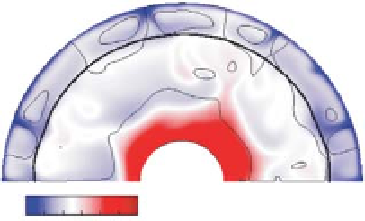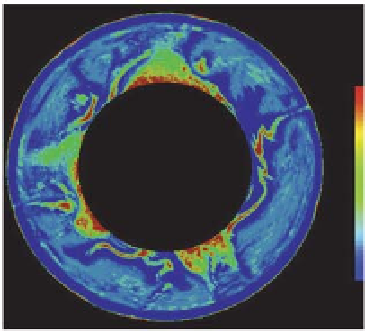Geoscience Reference
In-Depth Information
the full compressible terms is thermodynam-
ically significantly more consistent than the
often employed incompressible (Boussinesq or
Extended Boussinesq) approaches. The compress-
ible models can also be better compared with
seismology (which sees the Earth as a compress-
ible medium) and the inclusion of consistent
mineral physics can be achieved (e.g., Tirone
et al
.,
Karato, 2003). For example, the oceanic crust is
expected to be denser than ambient mantle in the
upper mantle and in most of the lower mantle,
except in a small depth range in the uppermost
lower mantle where it is lighter than ambient
mantle. Crust separation may occur due to the
buoyancy effect if rheological contrasts between
crust and mantle are high (van Keken
et al
.,
1999), but a more likely separation mechanism
occurs when the crust is mixed back in and
transported back up through the transition zone.
The 670 km phase change tends to enhance this
filtering effect. Examples of the formation of a
somewhat fuzzy but compositionally distinct
layer in the uppermost lower mantle are provided
in a number of studies (e.g., Weinstein, 1992;
2009;
Nakagawa
et al
.,
2010,
Zunino
et al
., 2011).
A final important consideration is the role of
the transition zone. While the phase changes are
likely not sufficiently strong to strongly hinder
flow from the upper to the lower mantle, the
transition zone may provide a subtle chemical
filter, even in the absence of water (Bercovici &
0
1
0
1
C
T
(b)
(a)
C
1.0
0.5
0.0
(c)
Fig. 12.8
Thermochemical convection models with phase transitions from (top) van Summeren (EPSL, 2009) and
(bottom) Nakagawa
et al
. (2010). The endothermic phase transition at 670 km depth combined with compositional
variability between the MORB and harzburgite components causes localized and transient layering at 670 and may
lead to the long-term accumulation of MORB just below the transition zone. Reproduced with permission of
Elsevier. (See Color Plate 16).



